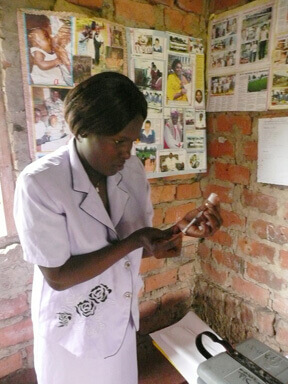Kaitlin ChristensonGHTC
Kaitlin Christenson is director of GHTC.
In a recent guest post for the ONE blog, GHTC director Kaitlin Christenson highlighted four game-changing HIV and AIDS interventions under development and the leadership from the US government that has helped foster these critical research breakthroughs.

The past three years have been historic in the number of breakthroughs in research to prevent, diagnose, and treat HIV and AIDS. For the first time, researchers proved that an HIV vaccine could prevent infection; an HIV prevention gel called a microbicide was shown to prevent infection among women; studies showed that a once-daily pill could reduce the risk of infection in high-risk individuals; and antiretroviral treatment among HIV-positive individuals was proven to reduce the risk of infecting their partners.
"The fight against HIV and AIDS is not over, and a concerted effort must be made to prioritize research to develop new tools." Photo: Robin Biellik/PATHIt’s been incredible to see such progress over the past three years. But to be clear: these breakthroughs are a result of a long-standing commitment by international donors to boost research for HIV and AIDS. Innovations like these come as a result of years of work conducted by a variety of players—the private sector, NGOs, academic institutions and product development partnerships. In many cases, they are a direct result of the support provided by the US government.
This commitment to research will continue to result in tools that change the way we approach the epidemic. Some impressive work is currently underway and promises to yield new interventions:
On a recent trip to Kenya, my colleagues and I had the opportunity to meet with some of the research heroes who are leading the way in studying these and other interventions. The excitement they felt about the promise these new tools might provide was palpable. Lisa Mills, an American based with the CDC in Kenya, co-led a clinical trial which provided evidence for treatment as prevention. She told us that this intervention will have a “huge impact on communities. It will make HIV-positive people in these communities non-contagious. It’s also more cost-effective to do treatment as prevention, since you’re only treating HIV-positive people.”
In speaking about research for microbicides, another of the individuals we met, Elizabeth Bukusi, deputy director at the Kenya Medical Research Institute (KEMRI), told us, “I think this is one of the tools that gives us the opportunity that we could actually end the epidemic. I think we can move towards a complete AIDS-free generation that will completely stop the epidemic in its track using microbicides as part of the armament.” She added that the “US has been a critical partner in providing catalystic funds and also in funding a large number of the trials that have looked at microbicides. So US funding is absolutely critical to moving this agenda forward.”
Today, it is in our hands to decide the fate of future generations. The fight against HIV and AIDS is not over, and a concerted effort must be made to prioritize research to develop new tools — both those that are within arm’s reach, and those which still require much more study. Research is a long-term investment, and we must not give up on the commitments which have taken us this far.
The US government is a leading supporter for research that has yielded many of the innovations we have today, and this support must not waiver even in the midst of today’s constrained budget environment. Will our leaders continue to set the stage? Imagine the breakthroughs that would be possible if so.